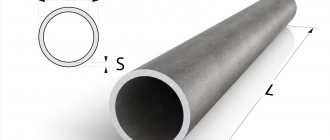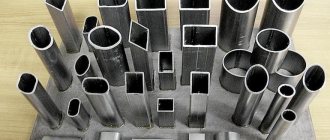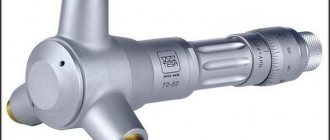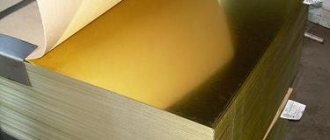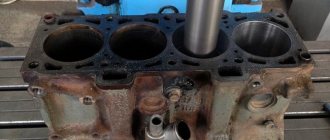Published on May 18, 2022 Category: Heat engineering | 33 comments
How much heat does the riser or deck of the heating system give off to the air in the room? How many degrees does the water cool in an insulated air heating system? How to properly and economically insulate a pipeline? Using the following…
...a program in Excel, you can quickly get accurate answers to these and other questions!
The object of research is a pipe with a coolant - water, surrounded by air space.
The next user functions (PF) of Vyacheslav Leonidovich Polkovov perform automatic calculation of the heat transfer of a pipe with and without surface insulation in any spatial position.
Let me remind you that a user-defined function (PF function, UDF function) in Excel is a program (macro) written in VBA in a program module of a file, and has the form:
y=f (x1, x2, x3, …, xn) , where:
- y – function value (the desired design parameter);
- x 1 , x 2 , x 3 , …, xn – values of the function arguments (initial data).
You can see a little more detail about working with custom functions in the previous blog article and read on the Internet.
For what purpose is the heat transfer of steel pipes calculated?
Mainly, the calculation of heat transfer of steel pipes is carried out in the following cases:
- if you need to determine the power of heating devices for the heating system in the house;
- if there is a need to assess heat losses occurring during transportation of the coolant through the pipeline.
It is worth noting that heating circuits through which heat can be emitted are installed in the following devices:
- heated towel rails and coils;
- registers;
- underfloor heating systems.
We make a calculation
The formula by which heat transfer is calculated is as follows:
Q = K*F*dT, where
- K – thermal conductivity coefficient of steel;
- Q – heat transfer coefficient, W;
- F – area of the pipe section for which the calculation is being made, m2 dT – temperature pressure value (the sum of the primary and final temperatures, taking into account room temperature), ° C.
The thermal conductivity coefficient K is selected taking into account the area of the product. Its size also depends on the number of threads laid in the premises. On average, the coefficient is in the range of 8-12.5.
dT is also called temperature difference. To calculate the parameter, you need to add the temperature that was at the outlet of the boiler with the temperature that was recorded at the entrance to the boiler. The resulting value is multiplied by 0.5 (or divided by 2). The room temperature is subtracted from this value.
dT = (0.5*(T1 + T2)) - Tk
If the steel pipe is insulated, then the resulting value is multiplied by the efficiency of the insulating material. It reflects the percentage of heat that was given off during the passage of the coolant.
Underfloor heating systems
If we are talking about a water heated floor, unlike its electric counterpart, it uses metal pipes as a heating circuit, although they have recently begun to be used less and less.
The main reason for the decline in demand for water-heated floors is the gradual wear of steel pipes and a decrease in the clearance in them. In addition, the installation method also matters - not everyone can make welds, and a threaded connection threatens to leak coolant after some time. Naturally, no one will like the result of water leakage from the system in a floor with a screed - the ceiling of the lower floor or basement will be flooded, and the ceiling will gradually become unusable.
For these reasons, steel pipes in warm water floors were first replaced by metal-plastic coils, the fittings of which were attached outside the screed, and now reinforced polypropylene is preferred.
This material has a slight thermal expansion, and with proper installation and operation, they can last for decades. Alternatively, other polymer materials are used.
Please note that gaps for thermal expansion of reinforced polypropylene still need to be left, although it is small.
We calculate the return for 1 m of product
It is easy to calculate the heat transfer of 1 m of pipe made of steel. We have a formula, all we have to do is substitute the values.
Q = 0.047*10*60 = 28 W.
- K = 0.047, heat transfer coefficient;
- F = 10 m2, pipe area;
- dT = 60° C, temperature difference.
It's worth remembering
Do you want to make a heating system correctly? You should not select pipes by eye. Heat transfer calculations will help optimize construction costs. In this case, you can get a good heating system that will last for many years.
The thermal conductivity of steel is quite high - this is a law of physics, and one cannot argue with it. But you can turn this property of metal to your advantage. It is this heat transfer that allows steel to be used in the production of various devices for heating rooms.
Heated towel rails
In old houses, heated towel rails made of steel pipes are very common, because in most cases they were laid out by the project, and almost until the end of the last century they were threaded into the system.
Not so long ago, they began to use circular inserts in elevator units, which ensure a stable hot temperature of the device.
Since the heating circuits in heated towel rails were constantly subject to temperature changes - they either heated up or cooled down - it was difficult for the threaded connections to withstand this regime, so they periodically began to leak.
Somewhat later, when the heating of these devices became stable thanks to the insertion into heating risers, the problem of leaks became less pressing. At the same time, the dimensions of the coil have become much smaller, resulting in a reduction in the heat transfer area of the steel pipe. However, such a heated towel rail remained warm not only while using hot water, but constantly.
Basic heating register calculation
If the level of heat transfer of a purchased battery can be found out from its passport, then in the case of homemade heaters you have to calculate everything yourself. Otherwise, it will not be possible to heat the room effectively and evenly.
Calculating the required radiator power to heat a room
For calculations, they use formulas that may be simple, but require certain mathematical skills. Another option is online calculators, of which there are now more than enough on the Internet. Strictly speaking, the topic is quite extensive and deserves a separate article, so we will use simple calculation methods
In any case, this issue should be given close attention, otherwise your family will complain that the radiators do not heat well and the room is cold
A simplified method for calculating the required thermal energy is to calculate the heating area and then multiply by 100. Why is this so? Because for comfortable living per square meter you need 100 W of heat. To be more precise in the calculations, let’s take into account the number of window openings and walls:
- A room with one window and one external wall – 100 W per 1 m² of area.
- A room with one window and two external walls - 120 W per 1 m².
- A room with two windows and two external walls - 130 W per 1 m².
Simple calculation of the thermal power of a radiator made of steel pipes
Knowing what to strive for, all that remains is to choose the design of the heating device that would satisfy your needs. How to do this?
There is an elementary solution - use a table. It already calculates the heat transfer rates of rolled pipes. The values take into account the temperature regime, in which the supply temperature of the coolant is +90℃, and the return temperature is +20℃.
So, the table below allows you to find out the thermal power of one linear meter of register pipe per square meter of heated area.
| External section of the pipe, mm | Heated room area, m² |
| 25 | 0,5 |
| 32 | 0,57 |
| 42 | 0,69 |
| 57 | 0,94 |
| 76 | 1,19 |
| 89 | 1,37 |
| 108 | 1,66 |
| 133 | 2,0 |
| 159 | 2,43 |
What other quantities do you need to know?
So, we have decided on the option - all that remains is to draw up a drawing. At this stage, such a parameter as the distance from section to section – h – is often forgotten.
When assembling a coil-type radiator from steel pipes, this value is determined by the dimensions of the bends used
Here it is worth paying attention to the value of F - this is the so-called outlet height. Without a doubt, the intersection distance here will be expressed by the formula:
h = 2F-D
If you decide to assemble a simple sectional radiator, then the gap between the pipes can be set independently, but with one condition:
H = D+50 mm
The same principle applies when working with rolled profiles, only instead of the diameter the height of the square or rectangular profile is used. Of course, the design features of the device are taken into account.
Methods for increasing heat transfer
The round shape does not at all help to increase the heat transfer of metal pipes. An even lower volume-to-surface ratio can only be found in a sphere.
Consequently, the problem of how to increase the heat transfer of a pipe undoubtedly faced the developers of the first simple heating devices.
To increase the heat transfer coefficient of a steel pipe, the following methods were previously used:
- The surface of the pipe was coated with matte black paint to enhance the infrared radiation of the heating element. This made it possible to achieve a significant increase in room temperature. It is worth noting that modern chrome plating on heated towel rails is extremely ineffective for enhancing heat transfer - it is, rather, for beauty.
- Increasing the heat transfer of the pipe by welding additional ribs onto it, which made the area of the heating element, and therefore the heat transfer, significantly larger. The most advanced use of this method can be called a convector, that is, a section of bent pipe with welded transverse ribs. Although the pipe itself in this case gives off a minimum of heat.
Any of these methods can be used if the question is how to increase the heat transfer of a heating pipe with your own hands, because they are not at all complicated and are quite feasible at home.
Calculation of pipe heat transfer in Excel.
To perform calculations, you must enter the source data into the MS Excel table. There are 13 of them. These are the physical parameters of the coolant (water), the ambient temperature, the geometric dimensions of the pipe and the thermal insulation layer, the thermal conductivity of the materials and the degree of blackness of the outer surfaces of the pipe and insulation.
The results cells automatically display the value of the heat output power of the pipe in Watts for four options, and the cooling temperature of the water in degrees Celsius during movement along a given section of the pipeline.
All 22 user functions involved in this Excel calculation program are each recorded in their own Module in the Modules folder. Access to the folder is in the Visual Basic Editor.
Heat loss through pipes
In apartment conditions, there is no particular point in calculating the heat transfer of a stainless pipe, because in this case all the heat given off by the riser and heating circuits will be dissipated inside, heating the room.
But if it is necessary to efficiently heat basement or warehouse facilities, and the coolant must be supplied to them from another place, then in this case, calculating the heat transfer of the pipe will be more than advisable so that you can figure out how much heat is lost along the way. Then you can try to look for ways to reduce heat loss from hot water pipes.
What are there
Heating registers are made of different materials and have different shapes. Each has pros and cons.
What are they made from?
If we talk about materials, the most common is steel, or rather electric-welded steel pipes. Steel does not have the best heat transfer, but this is compensated by its low price, ease of processing, availability and a large selection of standard sizes.
It is very rare to find pipes made of stainless steel - for decent power a large number of pipes are required, and you have an idea how much stainless steel products cost. If they did, it was probably a long time ago. They also use galvanized steel, but it is more difficult to work with - you won’t be able to cook it.
- Requires neutral and clean coolant, free of solid particles
- the presence of other metals and alloys in the system is undesirable, except for compatible ones - bronze, brass, nickel, chromium, therefore all fittings and fittings will need to be made from these materials;
- Careful grounding is mandatory - without it, in the presence of water, electrochemical corrosion processes begin;
- the softness of the material requires protection - covers are needed, etc.
There are registers made of cast iron. But they are too bulky. In addition, they have a very large mass; no less massive racks need to be made for them. Plus, cast iron is fragile - one blow and it can crack. It turns out that this type of registers also needs protective covers, and they reduce heat transfer and increase cost. Moreover, installing them is complex and hard work. The advantages include high reliability and chemical neutrality: this alloy does not care what coolant it works with.
In general, copper and cast iron are not easy. So it turns out that the optimal choice is steel registers.
Application of thermal insulation materials
Probably the first thing that comes to mind when it is necessary to retain maximum heat inside a pipe is to wrap it with heat-insulating material. At the end of the last century, fiberglass insulation with additional winding with non-flammable fabric was used for these purposes (this method is recommended by the regulatory framework). A little earlier, solutions of gypsum or cement were actively used, that is, the thermal insulation was solid. In reality, careless plumbers often simply wrapped the pipes with old rags, hoping that no one would check.
The abundance of modern materials, such as foam pipe linings, split polyethylene shells, mineral wool and others, allows for much better thermal insulation of heating pipes. And in new buildings such materials are successfully used. However, the backwardness of housing and communal services often leads to the fact that pipes are wrapped in rags the old fashioned way.
Making a heating battery from a profile pipe
A heating radiator is a device that can be manufactured not only by industrial companies, but also by home owners, including those new to this business. True, the latter will have to spend a lot of time. The easiest way is to make a battery from a profile pipe with a square or rectangular cross-section. This is because it does not spin and is easy to lock into place, allowing you to concentrate on all your welding and metal cutting work.
The design of a heating radiator made from a profile pipe is as follows:
- 3 horizontal pipes;
- 4 vertical jumpers;
- 6 plugs;
- couplings with internal threads welded to the ends of the upper and lower pipes.
Vertical bridges are placed at the ends of the pipes and allow water to flow from the top pipe to the bottom pipe.
Registers
The simplest design of heating radiators is registers. These are medium- or large-diameter pipes welded at the ends, single or connected in sections by jumper tubes. They can be seen in entrances, at industrial facilities or in private houses with individual heating.
Steel pipelines are considered traditional for the installation of water supply, sewerage and underground gas supply systems
To increase their thermal power, they use a method of increasing the area - thin metal plates are welded. This improves the heat transfer of the battery by almost one and a half times. Compact radiators, the closest relatives of cast iron accordion batteries, have approximately the same heat transfer. Although they are, of course, far from panel bimetallic devices.
To ensure maximum heat transfer from heating radiators, a simple and inexpensive convection method is used. This method involves hanging the device correctly. It is installed as close to the floor as possible, where cold air accumulates, but the gaps necessary for circulation are left, including near the wall itself.
With this installation, the battery sections come into contact with a medium that has the lowest possible temperature under the given conditions, that is, the thermal pressure increases. And the air heated by the registers, thanks to the gaps left, rises freely, and the room is heated faster.
An excellent method is to increase the heat transfer surface area. They do this in different ways:
- By increasing the total length of the heating pipes by forming them into U-shaped registers.
- With fins - strictly speaking, this method increases not specifically the thermal conductivity of the steel pipe, but of the entire radiator, but the power increases by 50%.
- Increasing the number of sections.
Black surfaces have the best heat transfer, but not every interior will fit such a dark battery, which is why this method has not found application. Registers traditionally continue to be painted white.
Possible installation errors
In order to avoid any technical difficulties after installation, it is necessary to provide for common errors that are often made during operation. So, if you install batteries less than 7 centimeters from the floor surface, then in the future we will be faced with the difficulty of not only cleaning underneath them, but also with heat exchange in the room. On the contrary, if you install the batteries higher than 15 centimeters, then, most likely, significant temperature changes will occur.
In addition, heat transfer may deteriorate if the radiator is installed close to the wall. Also, do not forget that you should not cover homemade pipe heating radiators with decorative grilles - this will lead to a decrease in their power.
Replacing batteries
If radiators need to be replaced, then it is advisable to start work in the warm season. The fact is that the heating is turned off during this period, so dismantling/installation can be carried out without any difficulties. Often, replacement is required if the equipment wears out or, alternatively, if it is necessary to reduce the number of sections. By the way, we prepare not only the batteries for replacement, but also the wall surfaces located behind them.
Note! We putty, level and paint the walls before installation, since after installation, as noted above, this will not be possible. Video - Replacing radiators
Video - Replacing radiators
Comparison of types of heating batteries - looking for the best
Previously, we reviewed and compared different types of heating radiators, thereby identifying their positive and negative sides; in addition to this article, we advise you to read this information
